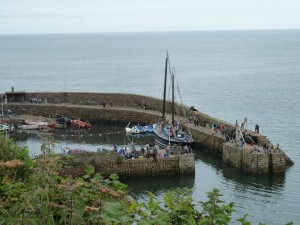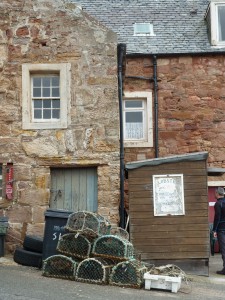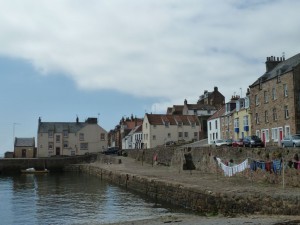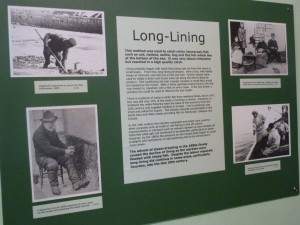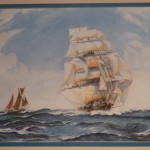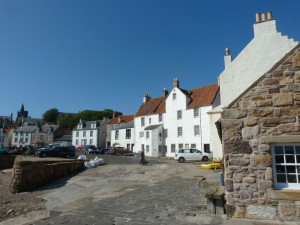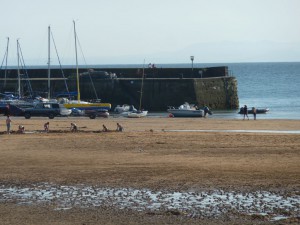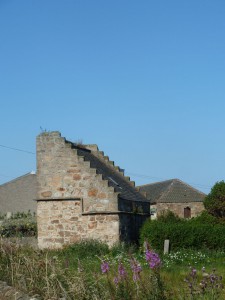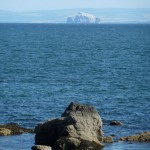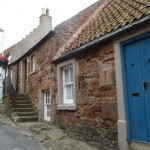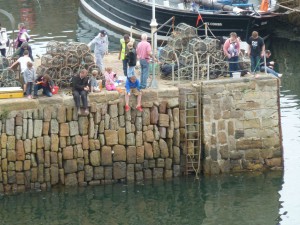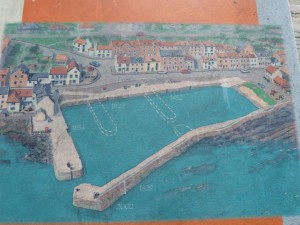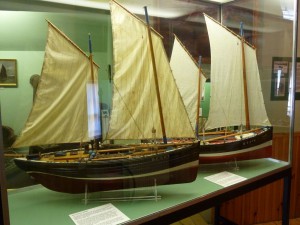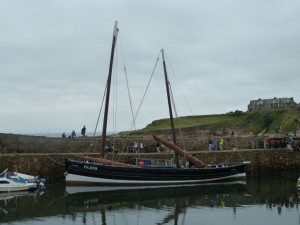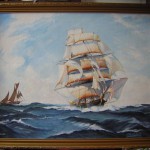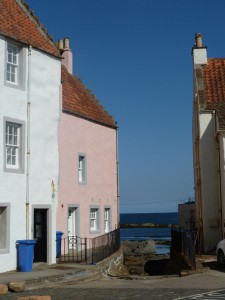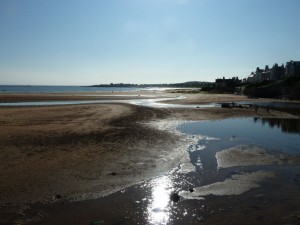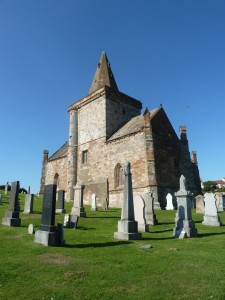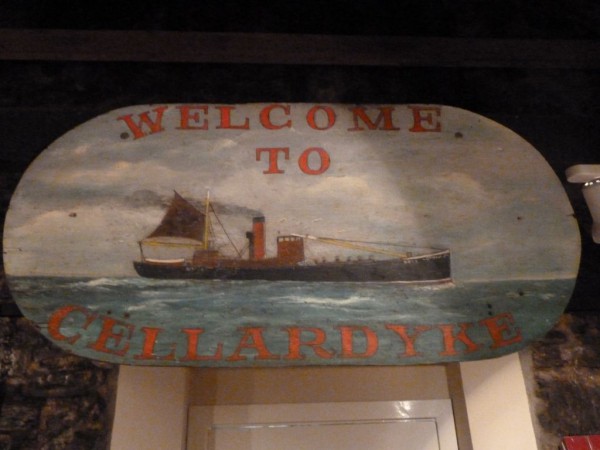Fìobha – bailtean East Neuk
An samhradh seo chuir sinn seachdain seachad anns an Rioghachd Fìobha agus ged a bha iomadh rud anns an sgìre air fad a bha tarraingeach agus intinneach, ‘s e bailtean iasgaich an East Neuk, Fìobha an Ear, a bu mhotha a chòrd rinn, ‘s dòcha air sgath ‘s gu bheil iad gu ìre mhath coltach ri ar bailtean ann an Ros an Ear. Ach tha iad brèagha agus taitneach gu leòr iad fhèin – ceart cho math, neo nas fheàrr, na na dealbhan-mìosachan air a bheil sinn uile eòlach.
An toiseach bha sinn ann an Cathair Aile (Crail) ann an taobh an ear an East Neuk agus abair gur e baile bòidheach a th’ ann, nas motha agus le coltas nas beartaiche na bha dùil againn. Chithear gur e baile stèidhichte a th’ ann, le eachdraidh malairt agus iasgaich, leis na taighean mòra cloiche air an togail le luchd-malairt anns a’ bhaile uachdarach agus na taighean is stòran susbainteach anns a’ bhaile ìarach faisg air a’ chidhe. Chithear buaidh Dhùitseach sa chidhe fhèin, a chaidh a thogail leis na leacan nan seasamh dìreach, seach nan laighe còmhnard. Tha na mullachan dearga air iomadh taigh ann am Fìobha, seach sglèata, a’ cur an cuimhne cuideachd linntean malairt leis an Òlaind. Bhiodh na bàtaichean a’ falbh le gual à mèinnean Fhìobha agus a’ tilleadh le leacagan-pana san toll mar balaiste. ‘S ann airson chrùbagan agus ghiomach a tha Cathair Aile ainmeil, is cliabhan-ghiomach nan laighe anns gach àite, agus na giomaich gan rèic ann am bothan air a’ chidhe fhèin. 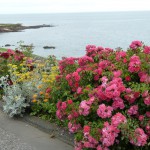 Latha an diùgh tha mòran fhlùraichean air na seann taighean agus timcheall air a’ bhaile agus gach taigh air a pheintadh geal is glan, rud nach robh iad uile roimhe gu cinnteach, nuair a bha dòigh-beatha iasgaich no malairt na bu chruaidhe. (PICTURES)
Latha an diùgh tha mòran fhlùraichean air na seann taighean agus timcheall air a’ bhaile agus gach taigh air a pheintadh geal is glan, rud nach robh iad uile roimhe gu cinnteach, nuair a bha dòigh-beatha iasgaich no malairt na bu chruaidhe. (PICTURES)
Ach bha sinn a’ dèanamh fiughair mòr a-nis ris an ath bhaile, oir chunnaic sinn air a’ mhapa gur e Cellardyke a bhiodh ann, aig a bheil ceanglaichean laidir ri Machair Rois, leis gu bheil càirdean againn, teaghlach Wood à Bail’ a’ Chnuic, uile a’ buinntainn dha bho thùs.
‘S e “Dykers” a ghabhas iad orra fhèin sa bhaile, agus bha mi èolach air an fhar-ainm “Dyker” no “Decker” ann am Bail’ a’ Chnuic o chionn bhliadhnaichean,. ‘S e ainm a bha air na sinnsearan aig neach-dàimh agus ban-charaid do mo mhàthar, Ceitidh Ros. Tha ùidh mhòr aig Ceitidh fhèin ann an eachdraidh an teaglaich, agus i a’ toirt iomradh gu trice air an àite. ‘S e “Fife Cottage” an t-ainm a bha air an taigh aca cuideachd. ‘S e baile nach eil ceart cho romànsach ri Cathair Aile a th’ ann an Cellardyke, ged a tha e bòidheach gu leòr cuideachd, le caladh nas motha agus coltas nas simplidh, leis na h-annartan a’ crochadh air an loidhne air a’ chidhe mar a bha e roimhe, agus glè bheag de luchd-tadhail ged a b’ e latha brèagha grìanach sna làithean-saora a bh’ ann. 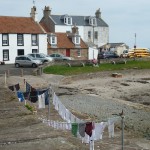 Bha àite-picnic snog ann, ge-tà, agus nach b’ e sinn fhìn a bha thoilichte a chleachdadh (mar as àbhaist – ‘s toil leinn picnics), agus clàr-fiosrachaidh glè inntinneach mun chaladh agus mun bhaile. Thàinig “Cellardyke” (thathar a ràdh) bho “Siller Dyke”, bho na lìntean làn lannan-èisg airgid a’ tiormachadh air a’ bhall-mara. Thog mi mòran dealbhan do Cheitidh…
Bha àite-picnic snog ann, ge-tà, agus nach b’ e sinn fhìn a bha thoilichte a chleachdadh (mar as àbhaist – ‘s toil leinn picnics), agus clàr-fiosrachaidh glè inntinneach mun chaladh agus mun bhaile. Thàinig “Cellardyke” (thathar a ràdh) bho “Siller Dyke”, bho na lìntean làn lannan-èisg airgid a’ tiormachadh air a’ bhall-mara. Thog mi mòran dealbhan do Cheitidh…
Nuair a bha sinn air ais aig an taigh lorg mi òran beag glè shnog is èibhinn mu dheidhinn Cellardyke, a chuireas mi aig an deireadh.
Tha Ànstruthair, no “Eanstar“, ceangailte ri Cellardyke an latha an diùgh, agus tha e mòran nas motha agus nas trainge, leis a’ bhùth fish and chips cho ainmeil agus caladh mòr làn bhàtaichean de gach seòrsa, ach ‘s e gheataichean a th’ anns a’ mhòr-chuid. Chan eil mòran ri fhaicinn de dh’eachdraidh iasgach a’ bhaile a-nis an sin, ach tha aon rud eile anns a’ bhaile a tha a’ dèanamh suas airson sin: Taigh-Tasgaidh Iasgach na h-Alba. Chan urrainn dhomh sin a mholadh cus. Nam bheachdsa bu chòir do gach Albannach a dhol ann aon turas na bheatha. ‘S ann ainneamh a bha mi ann an taigh-tasgaidh cho tarraingeach (agus bha mi ann an tòrr). Chan e taisbeanadh àbhaisteach a th’ ann, ach “galeraidhean” eadar-dhealaichte le modalan-bàta (Zulus, scaffies), le tableaux (caileagan-sgadain), le dealbhan-ola, le bhideos, agus le eachdraidh nam bàtaichean diofraichte fhèin, mar na “Zulus” (air an ainmeachadh mar sin oir bha urram mòr aig na h-Albannaich air na Zulus uasal gaisgeil aig amannan nan Cogaidhean Zulu). 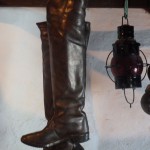 Chì thu cuideachd seòmraichean ann an taigh luchd-iasgaich le uidheam iasgaich tradaiseanta, agus tòrr fìor bhàtaichean, mòra is beaga, à eachdraidh iasgach na h-Alba ann an tallaichean mòra, fosgailte, soilleir. Tha a h-uile rud air an gleidheadh ann an sreath taighean-iasgaich agus gàrraidhean dìreach ri taobh a’ chidhe. Thug sinn grunn uairean a thìde ann. (Ach tha cafaidh ann cuideachd!)
Chì thu cuideachd seòmraichean ann an taigh luchd-iasgaich le uidheam iasgaich tradaiseanta, agus tòrr fìor bhàtaichean, mòra is beaga, à eachdraidh iasgach na h-Alba ann an tallaichean mòra, fosgailte, soilleir. Tha a h-uile rud air an gleidheadh ann an sreath taighean-iasgaich agus gàrraidhean dìreach ri taobh a’ chidhe. Thug sinn grunn uairean a thìde ann. (Ach tha cafaidh ann cuideachd!)
Tha seann bàta-siùil bhon àm iasgaich-sgadain aca, The Reaper (1902), a chunnaic sinn ann an caladh Baile Aile. ‘S ann à Ànstruthair agus Cellardyke a thàinig na sgiobairean Keay agus Rodgers aig an robh na clippers ainmeil Ariel agus Taeping anns na ‘tea races’ anns na 1860ean.
http://www.scotfishmuseum.org/
Chòrd rinn na h-ath àiteachean, Baile na h-Uaimhe (Pittemweem) agus St Monans (Baile Naoimh Moinenn), gu mòr cuideachd, is iad air an togail air tràigh àrdaichte ma a bha Cathair Aile, le pàirtean uachdrach leis na taighean nas motha agus na bùithtean, na h-eaglaisean agus na sgoiltean, agus pàirtean ìochdarach leis na calaidhean, agus na sràidean cas, cumhang, toinnte air a’ bhraigh eadarra. Chunnaic sinn barrachd eiseimplearan math mhullachan dearga agus “crow-stepped gables” gu leòr, an dà chuid a’ toirt iomradh air malairt le Òlaind a-rithist agus cho cudromach ‘s a bha Baile na h-Uaimhe an uairsin leis a chidhean mòra agus a mhargadh-èisg. ‘S ann anns an t-seann eaglais air a’ chreag ann an St Monans a phòs caraidean agam dà bhliadhna air ais agus ‘s e àite fìor bhrèagha, soilleir agus sàmhach a th’ innte, le sealladh mìorbhaileach air am Bass Rock.
Tha am baile mu dheireadh air an East Neuk, Elie, ceanglaite a-nis le Earlsferry, gu tùr eadar-dhealaichte. Tha caladh mòr ann, ach tha e làn ghainmheich a-nis agus nuair a bhios a’ mhuir a-muigh chan fhaic thu ach clann gun àireamh a’ togail caisteil-ghainmeich air. Thàinig an t-ainm Elie bho “Eilean Ard Rois” (chaidh an caladh fhèin a thogail air an eilean bheag sin), agus chunnaic sinn seann tucaid coltach ris an tè aig Cathabul faisg air “Ardross Farm” agus tobhta Caisteil Ardross. ‘S e MacDhubhaich a rèir choltais a bh’ anns an “earl” a chleachd an t-aiseag airson teicheadh bho MacBheatha.
Mura robh sibh anns an sgìre sin fhathast, dh’fhaodainn a moladh dhuibh. Tha tòrr ann air a bhiodh sibh eòlach gu leòr airson faireachdainn aig an taigh, ach aig an aon àm gu leòr rudan ùra, taitneach agus iongantach ann. Is fhiach fhaicinn!
http://www.undiscoveredscotland.co.uk/areastan/index.html
***************************************************************************
Fife – the East Neuk Villages
This summer we spent a week in the Kingdom of Fife, and although there are lots of attractive and interesting things in that area, it’s the fishing villages of East Fife that we liked the best. Maybe this is because they’re similar in some ways to our Easter Ross villages but they’re also attractive enough in their own right, just as good if not better than the calendar views we’re all familar with.
First we were in Crail at the eastern end of the East Neuk, and what a lovely town it is, bigger and more prosperous-looking than we’d expected. You can see that it’s a long-established town with a trading history too, with the big stone merchants’ houses of the upper town as well as the solid homes and storehouses in the lower town by the quay. You see the Dutch influence in the quay itself, with the slabs being placed vertically instead of horizontally. There are red tiles on many roofs in Fife, instead of slate, reminding us of the centuries of trade with Holland. The boats would leave with coal from the Fife mines and return with red pantiles as ballast. It’s for crab and lobser that Crail is famous, and there were creels lying everywhere and lobster being sold from a hut on the harbour. Nowadays there are lots of flowers on the houses and around the village and every house is freshly painted, which certainly wouldn’t have been the case back then when the the fishing and trading way of life was harder.
But we were now really looking forward to our next port of call, which we had seen on the map was Cellardyke, and which has close links with the Seaboard; the extended Wood family of Hilton, whom we’re connected to ourselves, all originated there. The inhabitants of Cellardyke proudly call themselves “Dykers” and I knew myself from my childhood that ancestors of my mother’s relative and friend, Katie Ross, had the by-name “Dyker” or “Decker”, and their house used to be called Fife Cottage. Katie, who’s very interested in family history, has often mentioned the town. Cellardyke isn’t as romantic a town as Crail, though it’s attractive enough too, with its large harbour and workmanlike appearance, and washing still flapping on the line down at the quay as it used to. There were very few visitors, despite it being a lovely sunny day in the holidays. We found a nice wee picnic spot there, though, and were happy to make use of it as usual (we love picnics, and we had the perfect weather for them), and read the very interesting information-boards about the harbour and the town. It’s said that Cellardkye comes from “Siller Dyke”, from the nets full of silver fish-scales hung out to dry on the seawall. I took lots of photos for Katie…
When I got back I found a very nice funny wee dialect song about Cellardyke, which I’ll quote at the end.
Anstruther, or Anster (pronounced “Ainster”), is joined directly on to Cellardyke nowadays and is much bigger and busier, with its famous fish and chip shop and its large harbour, full of small vessels of all sorts, though mostly pleasure-boats. You don’t see much of the area’s fishing history there now, but the town has something else that more than makes up for it – the Scottish Fisheries Museum. I can’t recommend that too highly. In my opinion every Scot should go there at least once in his life. I’ve seldom been in such a fascinating museum (and I’ve been in a lot). It’s not the usual display, but different themed ‘galleries’, with model boats (Zulus, scaffies etc), tableaux (e.g. herring girls), paintings, videos, and the history of the the different boats, like the Zulus (so called due to the respect the Scots had for the brave, noble Zulus during the Zulu Wars).
There are also rooms from a fisherman’s house, with the tools of their trade, and a whole series of real boats from Scotland’s fishing history, big and small, in large, bright, airy halls. The whole thing is housed in a collection of old fishermen’s houses and yards, right beside the harbour. We were there for hours (but there is a café!).
They also have a working 100-year-old sailing-boat from the herring fishing, The Reaper, which we saw in Crail harbour. It’s from Anstruther and Cellardyke that Captains Keay and Rodgers of the clippers Ariel and Taeping came, famous in the “tea races” of the 1860s.
http://www.scotfishmuseum.org/
We also really liked the next two towns, Pittenweem and St Monans, both built on raised beaches like Crail, the upper part with the bigger houses and the shops, the churches and schools, and the lower part with the harbours, and the steep, narrow, twisted streets on the brae in between. We saw more examples of the red roofs and also plenty of crow-stepped gables, both features reminding us of the trade with Holland, and of how important Pittenweem was then with its large harbour and fishmarket. Friends of mine got married in the cliff-top Auld Kirk of St Monans a couple of years ago, and it’s truly a lovely place, light and peaceful, looking straight over the Forth to the Bass Rock.
The last town of the East Neuk coast, Elie, now joined on to Earlsferry, is completely different. It has a large harbour, but it’s full of sand, and at low tide all you see is dozens of children building sandcastles.The name Elie came from “Eilean Ard Rois” (the harbour was built on that small island), and we saw an old crow-stepped doocot like the Cadboll one near an Ardross Farm and the ruins of Ardross Castle. The earl who used the ferry was allegedly Macduff, fleeing from Macbeth.
If you haven’t yet been in the area, I can only recommend you to go. There’s plenty you’d be familiar enough with to feel at home, but at the same time plenty of new, attractive and surprising things to see which make it well worth visiting.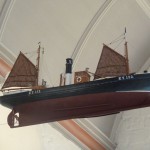
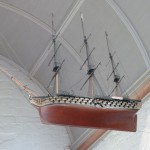
http://www.undiscoveredscotland.co.uk/areastan/index.html
Thanks to the Scottish Fisheries Museum in Anstruther for special permission to use photographs taken in the museum (as indicated).
**************************************************************************
Song: A Dyker’s Compliments to Her Neighbours
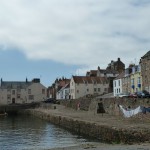 This song was made by Scott Murray of the Fife song group Sangsters. Scott went to visit a group of elderly ladies living in Ladywalk House in Anstruther as part of a songwriting project in Fife in 1998-2000 run by the organisation New Makars Trust which works to support people writing songs about where they live. (Ed. They were interested in the Seaboard, after I approached them for permission to print the song here, so maybe something will come out of that.)
This song was made by Scott Murray of the Fife song group Sangsters. Scott went to visit a group of elderly ladies living in Ladywalk House in Anstruther as part of a songwriting project in Fife in 1998-2000 run by the organisation New Makars Trust which works to support people writing songs about where they live. (Ed. They were interested in the Seaboard, after I approached them for permission to print the song here, so maybe something will come out of that.)
He explained that ‘The ladies were adamant that they were having nothing to do with actual songwriting. ‘Dinna be daft, son – is that not what ye dae?’ They came out with stories, I took notes of the gallus Dyker (Cellardyke, next to Anstruther) sayings and gathered together strands.’
Chorus
Keep yer ain fish guts tae yer ain sea maws
Anster daws, tattie shaws
Keep yer ain fish guts tae yer ain sea maws
Lyin amang the deid craws
An wha’s acht you ma bonnie lass
That moved here in the simmer?
Ah kent yer faither at the scale
He’s a torn-ersed Pittenweemer
Ye lookin at me, ye Anster daw?
Ah’ll cowp ye in a dub sir
An wha cried ye a partan face
An ye sae like a lobster?
What’s that ye’re sayin? Ah canna tell
Ye styipit shilpit moaner
Ye’re nae frae here, Ah’m shair o that
Ye’re a St Minnens droner
Ye can keep yer Crail an Pittenweem
Yer Anster an St Minnens
Daft Dyker’s whit ye cry us aa
Awa back hame, guid riddance
Listen to Scott singing it, inimitably, here: http://www.ltscotland.org.uk/scotlandssongs/secondary/genericcontent_tcm4572775.asp
Thanks to Scott and the New Makars for permission to use this, and to the LTS Scotland site for background and audio link.
The New Makars Trust: http://www.newmakarstrust.org.uk/
The Sangsters: http://www.scottish-folk-music.com/bands-singers-pages/band-sangsters.htm
